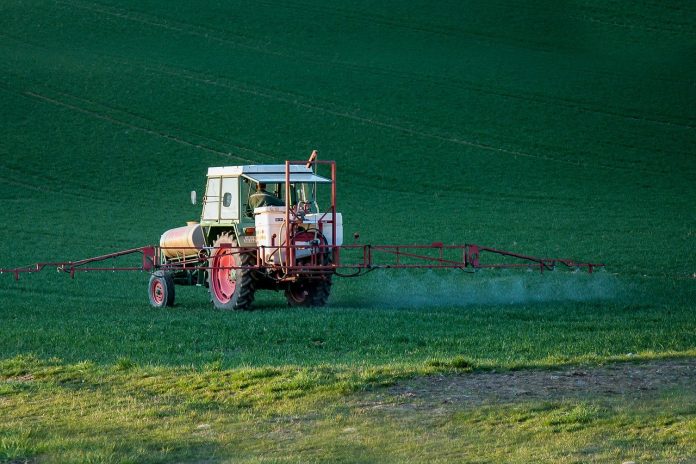There are multiple factors leading to herbicide shortages for the 2022 growing season, wrote Bill Johnson, Marcelo Zimmer and Bryan Young, of Purdue University, in an Oct. 8 extension newsletter.
The two main active ingredients that are experiencing shortages are glyphosate and glufosinate, which creates some major challenges for corn and soybean farmers.
Costs, in addition to just shortages, are also a concern. The authors said glyphosate prices could be more than $80 per gallon, so farmers should plan weed control strategies that will work with limited availability of those two ingredients, whether because of supply or price.
The authors offered several suggestions for minimizing the impact of the shortage in the Midwest.
Tillage
No-till systems typically need more glyphosate than conventional till systems, especially for systems that use cover crops and have to terminate them before planting corn or soybeans.
So, going back to using tillage for fall and early spring weed control is one way to cut back on glyphosate needs, the authors said. That practice does come with some drawbacks — not all farms have the equipment, labor and fuel to do this, and replacing burndown herbicides with tillage could threaten soil conservation practices.
Tillage systems don’t impact glufosinate demand as much, since it is mostly used in soybeans, after the crop and summer annual weeds have emerged. Farmers who don’t want to return to widespread tillage should look for ways to control winter annual weeds before planting and grass weeds with other herbicides to be less reliant on glyphosate.
Residual program
Farmers will need to build a solid residual program for weed control to rely less on glyphosate after crops emerge, the authors said. There are a couple of things to consider, based on the type of tillage system a farmer has and the weeds they need to control at different times of year.
Those who use cover crops can plant covers that produce high biomass, including cereal rye, to suppress horseweed. Applying 2,4-D or dicamba in the fall, if a farmer doesn’t plant legumes with the cereal rye, can control winter annual broadleaf weeds that emerge before the winter freeze. High biomass cover crops can also help in the 2022 growing season, and sometimes suppress waterhemp and annual grasses.
Those who don’t use cover crops and use fall-applied herbicides for winter annuals can try taking out glyphosate and just using mixtures of 2,4-D and dicamba if they only have broadleaf weeds in their fields. Those with grass weeds that are small and actively growing can try reduced rates of glyphosate for the grasses and rely on the other mixtures for broadleaf weeds.
Mixing these two things, however, can compromise grass control, so farmers should make applications on a warm day and add AMS to the mix to minimize that risk. Adding saflufenacil can also help speed up glyphosate’s activity on some annual grasses.
Other active ingredients that can help control winter annual grass weeds in the fall include paraquat, clethodim and rimsulfuran, though those herbicides will be more limited in the spectrum of weeds they address than glyphosate. It’s important to identify which weeds are in your field and check if the product you use will handle those weeds.
No-till
For no-till corn acres, farmers need a program that will control the winter annual and early spring and summer annual weeds that emerge, fit the crop being grown that summer and consider the list of premixes that might have a combination of atrazine, isoxaflutole, mesotrione, rimsulfuron or thiencarbazone, metribuzin, or saflufenacil in them.
All of those herbicides have some foliar activity on early spring weeds and fit into a no-till burndown. Farmers will also need a group 15 herbicide for their soil residual grass and small seeded broadleaf weed control program, Johnson, Zimmer and Young wrote.
Farmers can plan ahead by taking a look at their supply of these active ingredients and building their weed control programs around full rates of residual herbicides. This can minimize how much they have to rely on herbicides after emergence. Weed control guides can help farmers decide what herbicides will work best for the weeds they are dealing with.
Farmers can stretch glyphosate and glufinosate supplies over more acres by building a program that only requires them to treat their acres once after emergence with those active ingredients, and possibly at a lower rate than the maximum labeled rate.
Farmers, however, should not wait for the last weed flush before spraying, even if they only get one application of these herbicides. The best route is to use a reasonable rate on small weeds, with the best application method and adjuvant system possible, the authors said. Residual herbicides can be used to handle other weed flushes.
Other tips
The authors made several other suggestions, as well. Farmers can consider using the standard rate on the label, such as 22 ounces per acre for Roundup, as opposed to using 32 or 44 ounces per acre, to help stretch supply. They may also be able to identify glyphosate or glufosinate premixes that are in greater supply or at lower relative costs.
Because failure is not an option for herbicide applications this year, farmers should use the best methods, adjuvants and minimal weed size to optimize their herbicide applications. They can also substitute alternative corn post herbicides that control grasses and broadleaves — if they don’t include a residual group 15 herbicide, they can add one to the postemergence mixture.
Farmers should also cultivate if needed, or if possible, and hand weed escapes before the weeds set seed.
To read the full article in the newsletter, visit extension.entm.purdue.edu/newsletters/pestandcrop/article/herbicide-shortage-how-to-plan-for-the-2022-growing-season.










